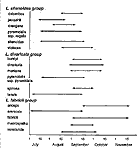 |
|
Figure 1. Flowering phenology of southern
African species of subgenus Lapeirousia (i.e., excluding
L. odoratissima and L. littoralis subsp. caudata). Species are arranged alphabetically in their respective floral guilds (Tables 2-5). |
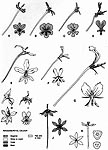 |
|
Figure 2. The main flower types in subgenus Lapeirousia, and selected flowers of other families resembling these flower types which are visited by the same insects that are the primary pollinators of Lapeirousia species.---A.
L. silenoides.---B. Pelargonium sericifolium.---C. P. magenteum.---D. P. incrassatum.---E. L. fabricii.---F. Pelargonium zonale.---G. P. longicaule. H. L.
divaricata (note prominent toothlike ridges on the lower tepals).---I. Pelargonium scabrum.---J. L. oreogena.---K. L. montana (with transverse sections of the tube at different levels). Approximately x 2/3. |
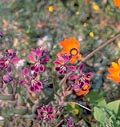 |
|
Figure 2A. The L. silenoides-type: L.dolomitica. |
Figure 2.
L. L. verecunda.
M. L. anceps.
N. L. fabricii. |
|
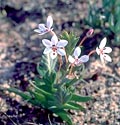
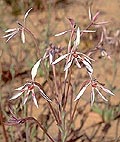 |
| Figure 3A. Prosoeca peringueyi foraging on Lapeirousia pyramidalis subsp. regalis. |
|
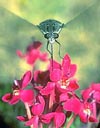
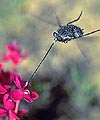
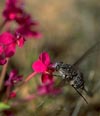 |
| Figure 3B. Prosoeca sp. nov. inserting its proboscis into the perianth tube of L. oreogena. |
|
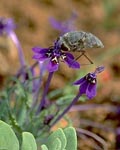
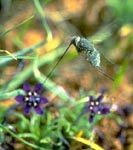 |
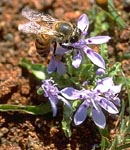 |
|
Figure 3C. Apis mellifera foraging on L. plicata. |
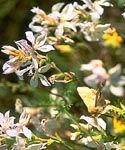 |
|
Figure 3D. The noctuid moth Heliotis armigera
grasping a flower of L. divaricata. |
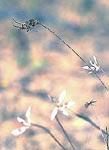 |
|
Figure 3E. Moegistorhynchus
longirostris about to forage on L. anceps. Photographs
were taken at study sites listed in Table 1. |
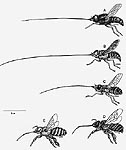 |
|
Figure 4. Primary pollinators of various
species of subgenus Lapeirousia. A. Prosoeca peringueyi (on L. jacquinii). B. Moegistorhynchus longirostris (on L. anceps). C. Philoliche gulosa (on L. fabricii). D. Anthophora diversipes (on L. divaricata). E. Parafidelia major (on L. barklyi). Scale bar
= 10 mm. |
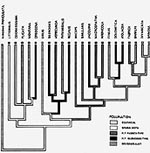 |
Figure 5. Phylogenetic tree showing
putative relationships of the species of subgenus Lapeirousia
(from Goldblatt & Manning, in mss) with pollination syndromes
mapped on the branches. The cross in the block below the species
name indicates pollinator(s) inferred from floral morphology.
The tree is one of four equally parsimonious trees obtained using
the Hennig86 package of programs for cladistic analysis (Farris,
1988), after successive weighting, consensus index (CI) 81, retention index (RI) 91. The initial analysis using the mh* and bb* options yielded 1332 equally parsimonious trees, length 74, CI 48, RI 67. The four final trees differed in the position of only two
terminal taxa and do not affect our conclusion that the two long-tongued fly pollination systems evolved independently several times in subgenus Lapeirousia. The details of the cladistic analysis are presented in detail in a separate paper (Goldblatt & Manning, 1966). |















